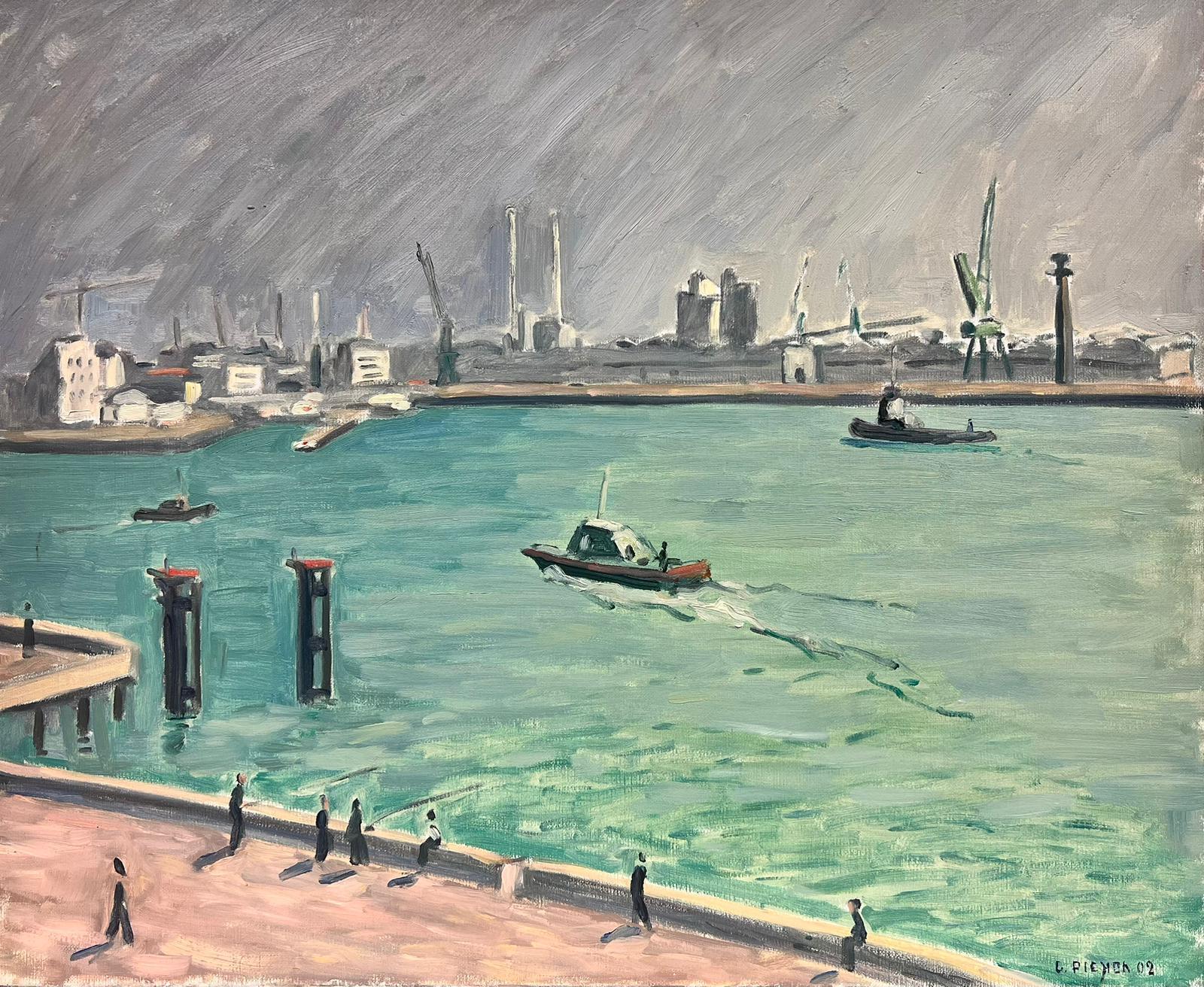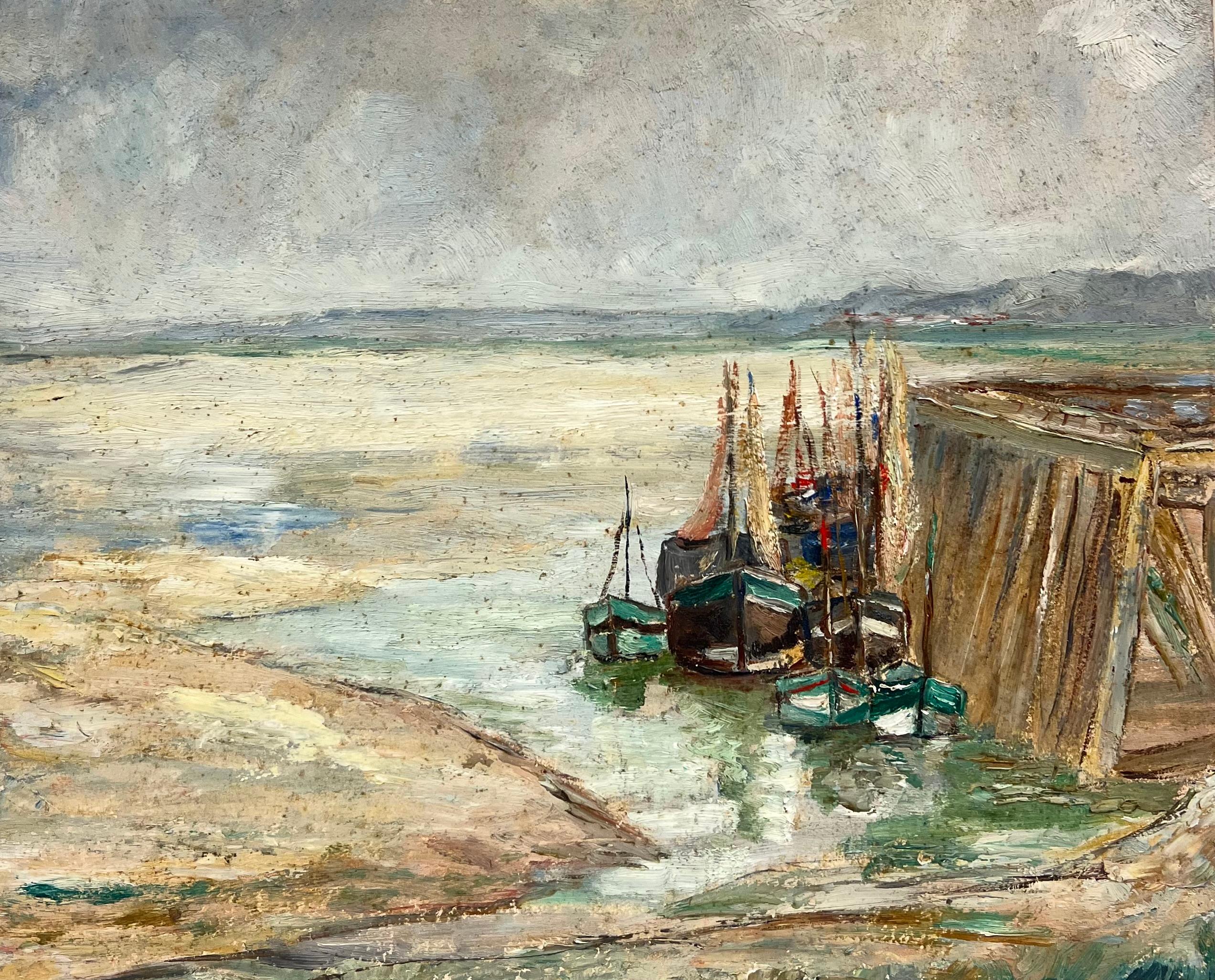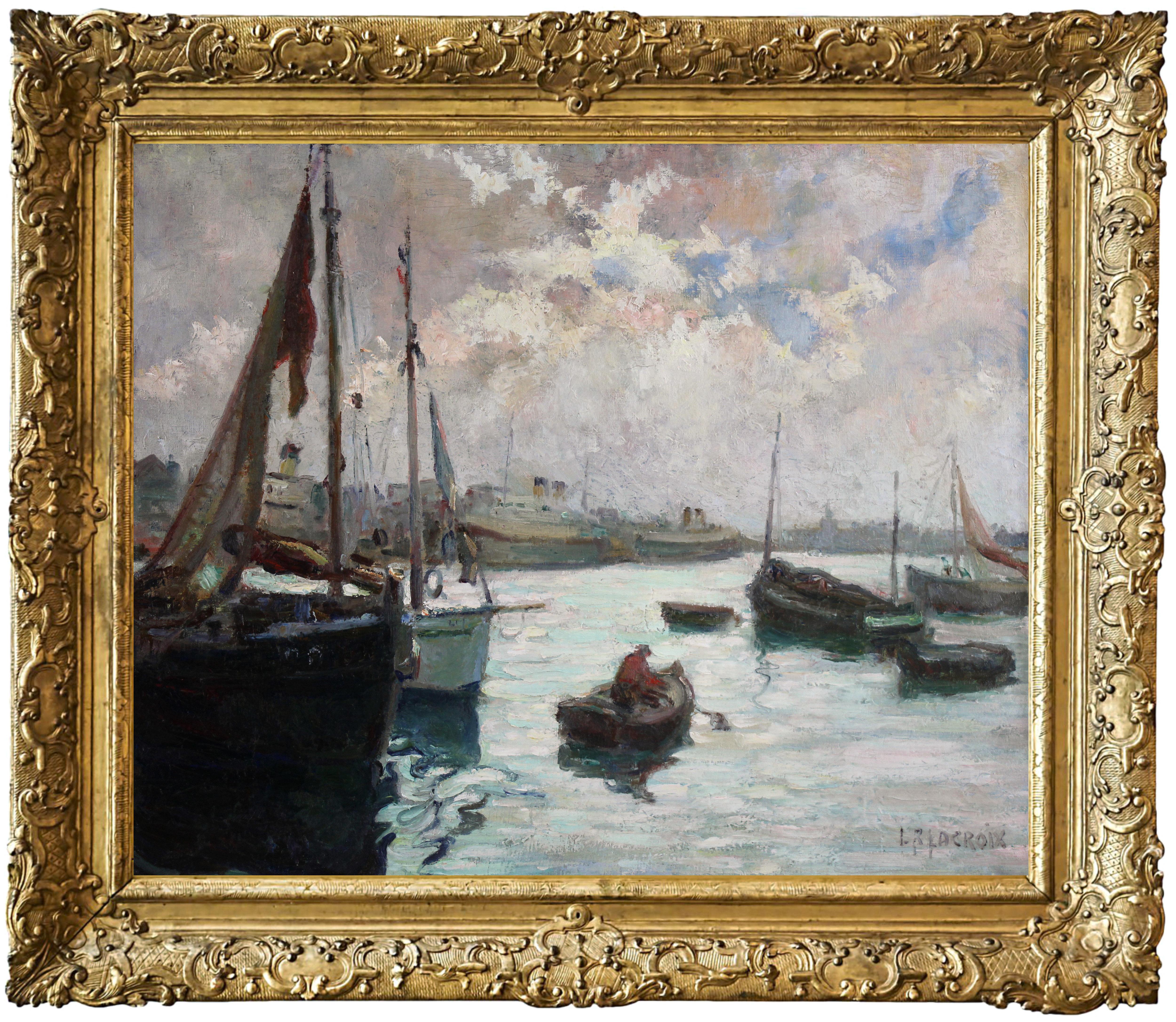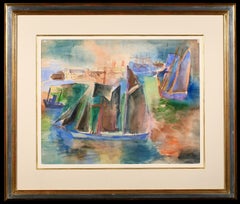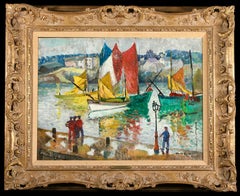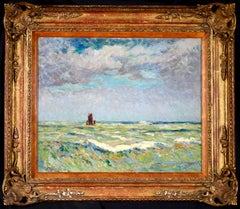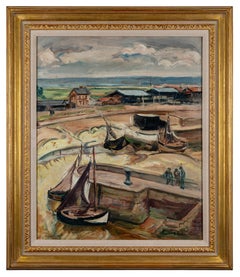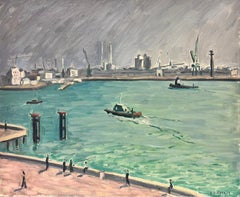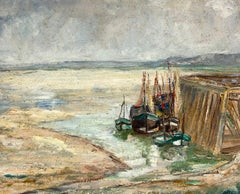Artículos similares a Puerto de Le Havre y Sainte-Adrese- Óleo postimpresionista de paisaje marino - Othon Friesz
¿Quieres más imágenes o vídeos?
Solicita imágenes o vídeos adicionales al vendedor
1 de 17
Achille-Émile Othon FrieszPuerto de Le Havre y Sainte-Adrese- Óleo postimpresionista de paisaje marino - Othon Friesz1921
1921
23.381,74 €
Acerca del artículo
Signed and dated oil on canvas seascape by French post impressionist painter Achille-Emile Othon Friesz. The piece depicts a view of Le Havre, a port city in Normandy, France, located at the mouth of the Seine River on a stormy day. Sainte-Adresse is a coastal suburb located 2 miles (3.2 km) northwest of Le Havre city center. There are boats out at sea under an overcast sky and works on the beach to the foreground.
Signature:
Signed and dated 1921 lower right
Dimensions:
Framed: 31"x38"
Unframed: 26"x33"
Provenance:
Private French collection
The authenticity of this work has been confirmed by Mme. Odile Aittouarès
Achille-Émile Othon Friesz was the son of a family of sailors from Le Havre. From 1885 he often spent time in Marseilles visiting his maternal uncles. As a child he dreamed of going to sea, but from the age of 12 he developed a passion for art, and after secondary school he attended the École des Beaux-Arts in Le Havre. There, from 1896 to 1898, he studied under Charles-Marie Lhullier who had been a friend of Jongkind and whom, like Dufy and Braque, he remembered fondly throughout his life. Lhullier introduced his students to the work of Chardin, Corot, Géricault and Delacroix.
After receiving a bursary from the local authorities in 1898, he went to Paris and, while his friends Matisse, Rouault and Marquet studied under Gustave Moreau, enrolled at the École des Beaux-Arts at the studio of Léon Bonnat, where he was joined by Dufy. However, he scarcely attended the studio, preferring to go to the Louvre and make copies of the works of Clouet, Veronese, Rubens, Claude Lorraine and Delacroix. He did his military service in Paris in 1902 but continued with his art. Around this time he met Camille Pissarro and sought his advice.
As a young man he began to make frequent trips away, not necessarily travelling very far, but looking for subjects for his work, usually landscapes. Among the places he visited were the Creuse region around 1903, Antwerp in 1905, returning there with Braque in 1906, and La Ciotat, Cassis and L'Estaque in 1906-1907, again in the company of Braque. In Paris he frequently moved lodgings until 1914. He moved in with Henri Matisse at the Couvent des Oiseaux from 1905-1910, that is to say at the period when Fauvism was at its height. In 1908 he returned to his native Normandy to reimmerse himself in his early environment; he would return to the region throughout his life. He made a trip to Munich with Dufy in 1909, and visited Portugal in 1911-1912 and Belgium in 1912. In 1914 he was called up and assigned to technical services, not being demobilised until March 1919, although he did manage to maintain a certain independence. From 1914 until his death he lived in Paris at 73 Rue Notre-Dame-des-Champs, where he occupied Bouguereau's old studio. He made frequent trips to Cap-Brun near Toulon where, in 1923, he acquired a property called Les Jarres, as well as making numerous visits to Normandy and Le Havre.
In 1925 he received the highest commendation at the Carnegie Prize in Pittsburgh for Portrait of the Decorative Artist Paul Paquereau. Also in 1925, at the same time as Matisse, he was made a Chevalier of the Légion d'Honneur, rising to in Officier in 1933 and Commandeur in 1937. He was also made Commander of the Swedish order of Vasa in 1934. Throughout his life, Friesz was a teacher: from 1913 at the Académie Moderne; from 1929 at the Académie Scandinave; and from 1941 until his death at the Académie de la Grande-Chaumière.
Alongside his activity as a painter, he illustrated several works of literature, including: in 1920 Le Pacte de l'Écolier Juan by Jules Tellier; in 1924 Échelles de Soie by Jean Pédron; in 1926 Le Jardin sur l'Oronte by Maurice Barrès; in 1926 En Suivant la Seine by Gustave Coquiot; in 1929 Rouen by André Maurois; in 1931 The Song of Songs; in 1934 Poésies by Pierre de Ronsard; in 1945 Le Bouquet de la Mariée by Gabriel-Joseph Gros; in 1947 Paul et Virginie by Bernardin de St-Pierre; in 1949 Le Livre de Job by Pierre Poussard; in 1949 Petronius's Satyricon, and in 1949 a collection of 12 unpublished lithographs for Le Désert de l'Amour by François Mauriac. He also designed several pieces of decorative art: from 1906 to 1909 ceramics executed by Metthey among others; a façade for a private house in Le Havre; a china service for two for the Le Havre writer J.-G. Aubry; vases, dishes and plates; in 1912 four sets for La Lumière by Georges Duhamel, performed at the Odéon; in 1916 a screen for the Le Havre collector Léon Pédron; in 1918 panels for Pédron's dining room; in 1920 a mural entitled Children Dancing (Enfants Dansant); in 1920 Les Volières for the apartment of Vicomte Amédée de Flers; in 1935 Peace (La Paix), a Gobelins tapestry presented by France to the Palais des Nations in Geneva; in 1937 La Seine in collaboration with Dufy for the Palais de Chaillot, with each artist taking half of the river's course - From the Source to Paris by Friesz and From Paris to the Estuary by Dufy.
The Fauves were producing Fauve paintings before they knew it: it was not until the critic Louis Vauxcelles saw their work at the Salon des Indépendants in 1905 and mockingly used the word Fauve to describe it that the term was born. It is known that Vlaminck and Derain worked together and that the École de Chatou was composed of just these two artists. Friesz was living with Matisse and after his first trip to Antwerp in 1905, he returned in 1906 with Braque. In 1906-1907 Friesz and Braque went to La Ciotat to paint and there they met up with Matisse. The paintings Friesz produced in Antwerp are Fauve inasmuch as they are painted in pure colours and are more or less free of the divisionism of the Impressionists, although the draughtsmanship is fairly standard; these works include The Port, The Escaut, The Canals, The Dock with Sailing Ships and The Red Slipway. Those of Braque the following year, in particular Terrace on the Escaut, show great similarities with those Friesz painted of the same subject. Friesz was already avoiding the hardness of pure flat tints by graduating them in thin glazes, allowing the whiteness of the canvas to penetrate the transparency, a technique that came to characterise his entire Fauve period.
At La Ciotat Friesz and Braque adopted completely different Fauve styles, with Braque composing his paintings on horizontal and vertical orthogonals painted in small, regular, spaced-out touches, whereas Friesz developed his own personal rhythmical style of wide arabesques of colour in works such as The Bec-de-l'Aigle, Women Bathing and L'Estaque. Many of Friesz's Fauve works were produced in the south of France, and his Portrait of Fernand Fleuret also dates from this period.
When he returned to Normandy in 1908 the period that he described as his 'return to form' began; with compromise paintings such as Entrance to the Port of Honfleur, Côte de Grâce Landscape, The 'Bains Marie-Christine' in Le Havre and the great compositions characteristic of this period - Autumn Labours, Spring, Fisherman on a Rock and Women Bathing. His draughtsmanship retains something of the rhythm of the Fauve period, his figures following the lines of the landscape and the colour remaining clear and resonant. In 1909 he painted the Cirque Médrano series: The Trapeze Artist, The Clown and The Horsewoman. In the south of France he also painted the Olive Trees series. He made a trip to Munich with Raoul Dufy resulting in Winter in Munich. This was also the year of his first trip to Italy. Boat in a Rocky Inlet of 1910 marks one of the pivotal points between a totally rhythmic drawing style of sensual curves typical of his Fauve period and a reduced palette of muted ochres, browns and blues. From 1910 onwards, the final traces of Fauvism become less and less apparent in his work. His use of colour follows the same course, towards the transcription of reality, with broken tones, ochres and browns.
After his demobilisation, as well as in his studio in Paris, Friesz spent time in his house in Toulon, returned to Normandy and Le Havre and continued to make frequent, often local, forays in search of new subjects: in 1919 to Jura, producing the series Forests, Pine Trees, Road in the Snow and Invitation to Skate; in 1920 to Italy producing Piedmont Village, Florence Grape Pickers; in 1920 to Le Havre, producing The Étretat Cliffs, People Bathing at Étretat; in 1923 to his house in Toulon, producing View of Coudon, Women Bathing, Grape Harvesting, Jars; in 1924 he painted the Large Nude (which he exhibited at the Salon d'Automne the same year) and landscapes of Toulon; in 1928 he made a trip to Algiers, producing The Algiers Kasbah and its Phantoms; in 1931 to Annecy, producing Women Bathers by a Lake; in 1934-1935 to Dinan and St-Malo producing The Great Dinan Viaduct, The Dock with the Terre-Neuvas, After Bathing; in 1936 to Honfleur; in 1941-1944, remaining in Paris because of the war, he painted mainly still-lifes, including Studio Corner, Earthenware. In 1946 he returned to Honfleur; and in 1947 to La Rochelle producing The Port Tower, Tuna Boats, The Red Sail.
Numerically Friesz's work is dominated by landscapes but it should be remembered that throughout his career he tackled more ambitious compositions and appeared to do so with great ease. These include Boat in a Rocky Inlet of 1910 with its frolicking women bathers, Allegory of War of 1915 executed in 24 hours, Invitation to Skate of 1919, numerous paintings of Women Bathing over several periods and much later Women beside a Pond of 1944, which clearly demonstrates his attachment to Cézanne.
He exhibited at the Salon des Artistes Français from 1901 to 1903 and then at the Salon des Artistes Indépendants. From 1906 he exhibited annually at the Salon d'Automne, of which he later became a committee and jury member. In 1923 he took part in the founding of the Salon des Tuileries and became head of two of the Salon's sections. His work has been exhibited at countless group exhibitions all over the world. Among the most recent thematic exhibitions is Fauvism in Black and White. From Gauguin to Vlaminck, Fauvist Engraving and its Setting (Le Fauvisme en Noir et Blanc. De Gauguin à Vlaminck, l'Estampe des Fauves et son Environnement) at the Musée d'Art Moderne in Villeneuve d'Ascq in 2001.
He also showed his work in numerous solo exhibitions in Paris: his first in 1904 at the Galerie des Collectionneurs and another the same year at the Société des Peintres du Paris Moderne; in 1905 at the Galerie Berthe Weill; under contract at the Galerie Druet from 1907; with the Galerie Katia Granoff from 1924; and from December 1939 until his death with the Galerie Pétridès. He exhibited in Paris in other galleries than those with which he was contracted, and outside Paris he held solo exhibitions in 1913 at the Cassirer gallery, Berlin; in 1921, 1928, 1936 and 1958 in London; in 1921 and 1950 in Le Havre; in 1925 and 1929 in Brussels; in 1929 and 1938 in New York; in 1930 in Chicago; in 1938 in Zurich; and in 1948 in Lucerne and Geneva. His posthumous exhibitions and retrospectives include: a tribute in 1949 at the Salon d'Automne in Paris; a retrospective in 1950 at the Galerie Charpentier in Paris; an exhibition in 1950 in Geneva and again in 1953 at the Musée d'Art et d'Histoire; in 1950 at the Musée de Toulon; in 1950 in Marseilles; in 1951 at the Algiers museum; in 1951 at the Musée d'Honfleur; in 1956 at the Musée de Dieppe; in 1979 at the Musée de la Rochelle and the Musée de La Roche-sur-Yon; in 1989 the E. Othon Friesz, Rétrospective at the Galerie Katia Granoff, Paris; 1995, Émile Othon Friesz. Périodes Fauve et Cézannienne (1906-1920) at the Galerie Larock-Granoff in Paris.
Museum and Gallery Holdings:
Albi: drawings
Arles: drawings
Baltimore: Women Bathing (1926)
Copenhagen: Madame and Jacqueline F.
Copenhagen (Statens Mus. for Kunst): Motherhood (1914)
Geneva (MAH): St-Cirq-Lapopie (1946)
Geneva (Petit Palais): Corvette Entering Port (1906); Women Bathing (1907)
Grenoble: Allegory of War (1915); Grape Harvesting (1923); Le Coudon (1923)
Le Havre: Landscape
Leeds (City AG): Honfleur (1937, oil on canvas)
Lille (Mus. de Picardie)
Moscow: Rouen Cathedral (1908)
New York (MoMA)
Oslo: Autumn Labours (1908); The Red Street (1905)
Paris (MNAM-CCI): La Ciotat (1906); L'Estaque (1906); Portrait of Fernand Fleuret (1906); Portrait of Madame Andrée Othon Friesz (1923); Landscape of Méounes, Var (1925); Port of Dieppe (1930)
Paris (Mus. de l'Armée): The French Enter Strasbourg (1918); Maréchal Joffre on Horseback (drawings)
Paris (Mus. de l'Aviation): Air Force Camps during the 1914-1918 War (studies)
Poitiers: drawings and lithographs
St-Malo: Women Bathers by the Sea; The Old Town of St-Malo before the Destruction Caused by the 1939-1945 War (drawings)
Stockholm: Port of Honfleur
Toulon: The Artist's House at Toulon (1919); Nude (drawings)
Troyes (MAM, Pierre and Denise Lévy donation): L'Estaque (1906)
Zurich: Cassis Landscape (1909)
- Creador:Achille-Émile Othon Friesz (1879 - 1949, Francés)
- Año de creación:1921
- Dimensiones:Altura: 78,74 cm (31 in)Anchura: 96,52 cm (38 in)
- Medio:
- Movimiento y estilo:
- Época:
- Estado:Very good condition.
- Ubicación de la galería:Marlow, GB
- Número de referencia:Vendedor: LFA05041stDibs: LU415316484502
Achille-Émile Othon Friesz
Othon Friesz era natural de Le Havre, Francia, entre 1879 y 1949. Fue un artista francés del movimiento fauvista. Fue buen amigo de Raoul Dufy y conoció a Matisse, Marquet y Rouault, con los que expuso en 1907. En sus últimos años pintó en un estilo muy diferente al de sus primeros años. He respetaba el estilo de Cézanne, de composición lógica, tonalidad sencilla, solidez de volumen y marcada separación de planos, así como el sabor barroco de su estilo. Es conocido por la pintura fauve y tradicional, los paisajes, las naturalezas muertas y el estilo figurativo. He admiraba las obras de los modernistas. Sus obras se encuentran en importantes museos de todo el mundo.
Sobre el vendedor
5,0
Vendedor Oro
Vendedores premium que mantienen una calificación de +4,3 y tiempos de respuesta de 24 horas
Establecido en 2001
Vendedor de 1stDibs desde 2016
706 ventas en 1stDibs
Tiempo de respuesta usual: <1 hora
- EnvíoRecuperando presupuesto…Envío desde: Marlow, Reino Unido
- Política de devolución
Partes de esta página se han traducido automáticamente. 1stDibs no puede garantizar la exactitud de las traducciones. El inglés es el idioma predeterminado de este sitio web.
Garantía de autenticidad
En el improbable caso de que haya algún problema con la autenticidad de un artículo, ponte en contacto con nosotros en un plazo de 1 año para recibir un reembolso total. DetallesGarantía de devolución de dinero
Si tu artículo no es como se describe, sufre daños durante el transporte o no llega, ponte en contacto con nosotros en un plazo de 7 días para recibir un reembolso total. DetallesCancelación dentro de las 24 horas
Tienes un período de gracia de 24 horas para reconsiderar tu compra, sin preguntas.Vendedores profesionales aprobados
Nuestros vendedores de primera clase deben cumplir estrictos estándares de servicio para mantener la integridad de nuestros anuncios.Garantía de igualación de precios
Si encuentras que un vendedor publicó el mismo artículo por un precio menor en otro lado, igualaremos ese precio.Entrega global de confianza
Nuestra red de transporte de primera ofrece opciones de envío especializado en todo el mundo, que incluye envío personalizado.Más de este vendedor
Ver todoLe Port due Havre - Paisaje postimpresionista Acuarela de Jean Dufy
Por Jean Dufy
Paisaje marino postimpresionista en acuarela sobre papel, firmado y fechado, del pintor francés Jean Dufy. Esta colorida pieza representa barcos de vela en el puerto de Le Havre (Fra...
Categoría
Década de 1920, Posimpresionista, Pinturas de paisajes
Materiales
Papel, Acuarela
Puerto de St Ives - Figuras impresionistas Paisaje marino Óleo de Richard Hayley Lever
Por Richard Hayley Lever
Figuras firmadas en paisaje al óleo sobre tabla del pintor impresionista australiano-estadounidense Richard Hayley Lever. La obra representa veleros de vivos colores en el puerto de ...
Categoría
Principios del 1900, Impresionista, Pinturas figurativas
Materiales
Óleo, Lienzo
Tiempo tormentoso - Honfleur - Óleo postimpresionista, paisaje marino por H de Saint-Delis
Maravilloso óleo sobre lienzo de hacia 1908 del pintor postimpresionista francés Henri Liénard de Saint-Délis que representa un barco atracado en el puerto de Honfleur, en el norte d...
Categoría
Principios del 1900, Posimpresionista, Pinturas de paisajes
Materiales
Óleo, Lienzo
Grosse Mer - Etretat - Paisaje marino impresionista Óleo de Maxime Maufra
Por Maxime Maufra
Paisaje marino impresionista pintado al óleo sobre lienzo hacia 1895 por el artista francés Maxime Maufra. Esta impresionante obra representa un velero en un vasto océano. El agua ag...
Categoría
Década de 1890, Impresionista, Pinturas de paisajes
Materiales
Lienzo, Óleo
París - Les Inondations - Pintura al óleo de paisaje impresionista de Maxime Maufra
Por Maxime Maufra
Paisaje impresionista al óleo sobre lienzo firmado por el pintor francés Maxime Maufra. La obra representa a gente remando en barcas por las calles inundadas de París.
Firma:
Firma...
Categoría
Década de 1910, Impresionista, Pinturas de paisajes
Materiales
Óleo, Lienzo
Les Vagues a Agay - Pintura al óleo de paisaje marino fauvista de Louis Valtat
Por Louis Valtat
Paisaje marino fauvista al óleo sobre tabla firmado hacia 1900 por el pintor francés Louis Valtat. Esta impresionante pieza representa una vista de grandes olas rompiendo contra gran...
Categoría
Principios del 1900, Fauvista, Pinturas de paisajes
Materiales
Óleo, Panel
También te puede gustar
Vieux Bassin de Honfleur
Por Achille-Émile Othon Friesz
Achille-Emile Othon Friesz
Francés, 1879-1949
Vieux Bassin de Honfleur
Óleo sobre lienzo
23 ½ por 28 ¾ pulg., con marco 31 ⅜ por 36 ½ pulg.
Firmado abajo a la derecha
Achille-Emile...
Categoría
principios del siglo XX, Fauvista, Pinturas de paisajes
Materiales
Óleo
Pintura al óleo firmada por un impresionista francés Barcos en un ajetreado puerto industrial
El Puerto
de Guy Pichon (francés 1933-2007)
óleo sobre lienzo, sin enmarcar
firmado
lienzo: 21 x 26 pulgadas
procedencia: colección privada, Francia
El cuadro está en muy buen est...
Categoría
Siglo XXI y contemporáneo, Impresionista, Pinturas de paisajes
Materiales
Óleo
Vue Du Vieux Port De Dieppe (Francia), 1920-30 - óleo, 98x116 cm. enmarcado
Por Leopold Levy
Óleo sobre lienzo, firmado abajo a la izquierda
Henri-Léopold Lévy (23 de septiembre de 1840, Nancy - 29 de diciembre de 1904, París) fue un pintor francés de ascendencia judía, cono...
Categoría
Década de 1920, Posimpresionista, Pinturas figurativas
Materiales
Óleo
Puerto en marea baja con barcos junto al muelle Impresionista francés de los años 30
Barcos de Marea Baja
Simone Forge Impresionista francés de 1930
óleo sobre tabla sin enmarcar
tablero: 13 x 16 pulgadas
Procedencia: colección privada
Estado: gran estado
Para má...
Categoría
principios del siglo XIX, Impresionista, Pinturas de paisajes
Materiales
Óleo
Óleo francés sobre lienzo " Vibrante escena portuaria en Dieppe "
Óleo francés sobre lienzo " Vibrante escena portuaria en Dieppe "
Información adicional sobre la obra:
Título: Vibrante escena portuaria en Dieppe
Técnica: Óleo sobre lienzo
Firma:...
Categoría
Década de 1920, Impresionista, Pinturas de paisajes
Materiales
Lienzo, Óleo
Promenade Le Havre Harbor French 1950s Cuadro al óleo enmarcado Mid 20th Century
Por Fred Pailhès
Alfred Henri Pailhès.
Francés ( n.1902 - d.1991 ).
Rendez-Vous Des Havrais Pour Leur Promenade Dominicale.
Óleo sobre tabla.
Firmado abajo a la izquierda.
Tamaño de la imagen 12,4 pu...
Categoría
mediados del siglo XX, Posimpresionista, Pinturas de paisajes
Materiales
Óleo, Tablero

